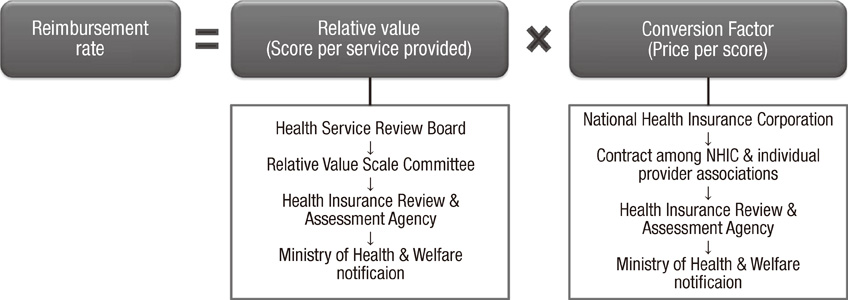J Korean Med Sci.
2012 May;27(Suppl):S25-S32. 10.3346/jkms.2012.27.S.S25.
Forecasting the Future Reimbursement System of Korean National Health Insurance: A Contemplation Focusing on Global Budget and Neo-KDRG-Based Payment Systems
- Affiliations
-
- 1Department of Health Services Management, Kyung Hee University School of Management, Seoul, Korea. Lukekim@khu.ac.kr
- KMID: 1714485
- DOI: http://doi.org/10.3346/jkms.2012.27.S.S25
Abstract
- With the adoption of national health insurance in 1977, Korea has been utilizing fee-for-service payment with contract-based healthcare reimbursement system in 2000. Under the system, fee-for-service reimbursement has been accused of augmenting national healthcare expenditure by excessively increasing service volume. The researcher examined in this paper two major alternatives including diagnosis related group-based payment and global budget to contemplate the future of reimbursement system of Korean national health insurance. Various literature and preceding studies on pilot project and actual implementation of Neo-KDRG were reviewed. As a result, DRG-based payment was effective for healthcare cost control but low in administrative efficiency. Global budget may be adequate for cost control and improving the quality of healthcare and administrative efficiency. However, many healthcare providers disagree that excess care arising from fee-for-service payment alone has led to financial deterioration of national health insurance and healthcare institutions should take responsibility with global budget payment as an appropriate solution. Dissimilar payment systems may be applied to different types of institutions to reflect their unique attributes, and this process can be achieved step-by-step. Developing public sphere among the stakeholders and striving for consensus shall be kept as collateral to attain the desirable reimbursement system in the future.
Keyword
MeSH Terms
Figure
Reference
-
1. Korea National Health Insurance Corporation. National health insurance statistics yearbook. 2009.2. Yim K, Chae Y, Choi J. A study on health reimbursement process and methodology, Korea. Korean Medical Association. 2008.3. Korea National Health Insurance Corporation. A study on conversion factors for types of healthcare institutions. 2007.4. Korean Institute of Hospital Management. Improving reimbursement per types of institutions, Korea. 2003.5. Kim Y. Problems of fee-for-service reimbursement system and alternatives. J Korean Health Secur. 2010. 9:8–24.6. Seoul National University. A study on cost analysis using management analysis data of hospitals, Korea. 2002. Seoul National University Press.7. Office of Inspector General. Medicare hospital prospective payment system: how DRG rates are calculated and updated. 2002. USA Department of Health & Human Services MEDPAC.8. Sloan FA, Morrisey MA, Valvona J. Effects of the medicare prospective payment system on hospital cost containment: an early appraisal. Milbank Q. 1988. 66:191–220.9. DesHarnais S, Chesney J, Fleming S. Trends and regional variations in hospital utilization and quality during the first two years of the prospective payment system. Inquiry. 1988. 25:374–382.10. Charles N, Weber A. Social health insurance: a guidebook for planning. 1994. USA: WHO-ILO.11. Korea National Health Insurance Corporation. Healthcare systems of major countries. 2009.12. Ministry of Health & Welfare, National Health Insurance Corporation, Health Insurance Review & Assessment Service. Guidelines to neo-DRG-based payment pilot project. Korea National Health Insurance Corporation. 2009.13. Korea Health Insurance Review & Assessment Service. An evaluation on neo-KDRG-based payment system pilot project. 2010.14. Lee M, Lee Y, Goh G. The change of medical care pattern and cost of cataract surgery by the DRG payment system in a general hospital. Korean J Hosp Manage. 2005. 10:48–70.15. Jung S, Lee Y. A trend of national health insurance reimbursement systems and improvement, Korea. Korean Hospital Association. 2010.16. Yim J, Kwon Y, Hong D, Kim C, Kim Y, Shin Y. Changes in the quality of healthcare in cesarian section after DRG adoption. J Prev Med. 1991. 34:347–353.17. Park Y. An analysis on clinic management. Korean Medical Association. 2010.
- Full Text Links
- Actions
-
Cited
- CITED
-
- Close
- Share
- Similar articles
-
- A Review of Healthcare Provider Payment System in Korea
- Changes in the Mixed Fee-Based Payment System in Primary Care: Cases and Implications
- The Adequacy on DRG Classification System in Obstetric Group
- Determination of Health Insurance Fee Schedule and Strengthening Policy for Health Insurance Coverage
- Payment reform for the improvement of primary care in Korea




